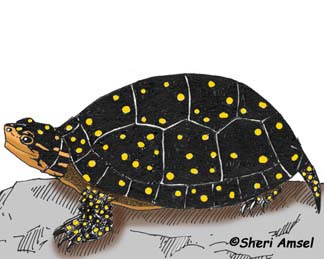

They are found in the eastern United States from southern Maine south to Florida and west to Michigan, and into Ontario.
They live in wet woodlands, boggy areas, wet meadows and muddy streams. Though they are often found near ponds, streams and small rivers, they are usually on land.
They are a small, dark turtle. They have yellow spots scattered on a smooth, dark shell and their legs and head. they have orange on their jaw.
They go into water to cool off, otherwise they live on land. In the northern part of their range they burrow into the ground or pond bottom and hibernate in the colder months. They can live for more than 100 years. They are endangered in many places from people collecting them for pets.
They eat plant and animal matter, so are omnivores. They feed on fish, insects, snakes, small birds, worms, berries, plants, mushrooms, etc. They are more carnivorous as young and eat more plant matter as they age.
Females nest in late spring to early summer. They dig a hole in sandy soil with their back legs, lay 3-8 white eggs and cover it again. Females lays eggs several times each year. They hatch in about 3 months, depending on the soil temperature.
Kingdom: Animalia
Phylum: Chordata
Subphylum: Vertebrata
Class: Reptilia
Order: Testudines
Family: Emydidae
Genus: Clemmys
Species: C. guttata
When you research information you must cite the reference. Citing for websites is different from citing from books, magazines and periodicals. The style of citing shown here is from the MLA Style Citations (Modern Language Association).
When citing a WEBSITE the general format is as follows.
Author Last Name, First Name(s). "Title: Subtitle of Part of Web Page, if appropriate." Title: Subtitle: Section of Page if appropriate. Sponsoring/Publishing Agency, If Given. Additional significant descriptive information. Date of Electronic Publication or other Date, such as Last Updated. Day Month Year of access < URL >.
Amsel, Sheri. "Turtle (Spotted)" Exploring Nature Educational Resource ©2005-2024. December 14, 2024
< http://www.exploringnature.org/db/view/Turtle-Spotted >

